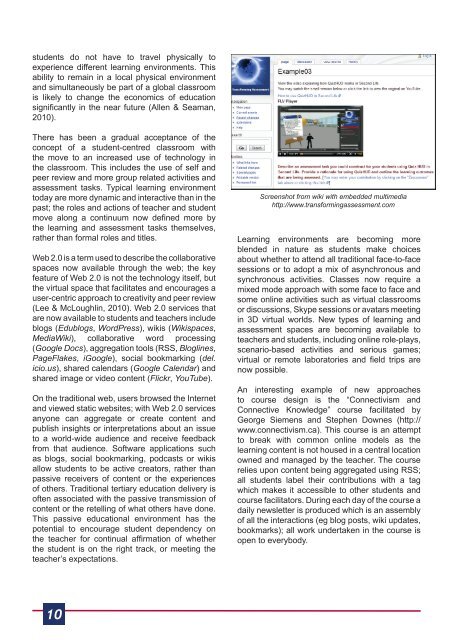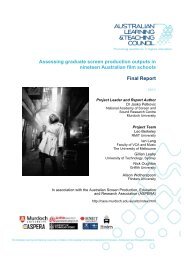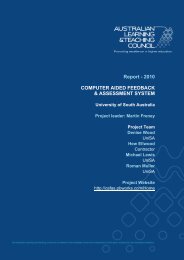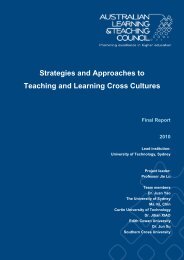Teacher's Handbook on e-Assessment - Office for Learning and ...
Teacher's Handbook on e-Assessment - Office for Learning and ...
Teacher's Handbook on e-Assessment - Office for Learning and ...
Create successful ePaper yourself
Turn your PDF publications into a flip-book with our unique Google optimized e-Paper software.
students do not have to travel physically to<br />
experience different learning envir<strong>on</strong>ments. This<br />
ability to remain in a local physical envir<strong>on</strong>ment<br />
<strong>and</strong> simultaneously be part of a global classroom<br />
is likely to change the ec<strong>on</strong>omics of educati<strong>on</strong><br />
significantly in the near future (Allen & Seaman,<br />
2010).<br />
There has been a gradual acceptance of the<br />
c<strong>on</strong>cept of a student-centred classroom with<br />
the move to an increased use of technology in<br />
the classroom. This includes the use of self <strong>and</strong><br />
peer review <strong>and</strong> more group related activities <strong>and</strong><br />
assessment tasks. Typical learning envir<strong>on</strong>ment<br />
today are more dynamic <strong>and</strong> interactive than in the<br />
past; the roles <strong>and</strong> acti<strong>on</strong>s of teacher <strong>and</strong> student<br />
move al<strong>on</strong>g a c<strong>on</strong>tinuum now defined more by<br />
the learning <strong>and</strong> assessment tasks themselves,<br />
rather than <strong>for</strong>mal roles <strong>and</strong> titles.<br />
Web 2.0 is a term used to describe the collaborative<br />
spaces now available through the web; the key<br />
feature of Web 2.0 is not the technology itself, but<br />
the virtual space that facilitates <strong>and</strong> encourages a<br />
user-centric approach to creativity <strong>and</strong> peer review<br />
(Lee & McLoughlin, 2010). Web 2.0 services that<br />
are now available to students <strong>and</strong> teachers include<br />
blogs (Edublogs, WordPress), wikis (Wikispaces,<br />
MediaWiki), collaborative word processing<br />
(Google Docs), aggregati<strong>on</strong> tools (RSS, Bloglines,<br />
PageFlakes, iGoogle), social bookmarking (del.<br />
icio.us), shared calendars (Google Calendar) <strong>and</strong><br />
shared image or video c<strong>on</strong>tent (Flickr, YouTube).<br />
On the traditi<strong>on</strong>al web, users browsed the Internet<br />
<strong>and</strong> viewed static websites; with Web 2.0 services<br />
any<strong>on</strong>e can aggregate or create c<strong>on</strong>tent <strong>and</strong><br />
publish insights or interpretati<strong>on</strong>s about an issue<br />
to a world-wide audience <strong>and</strong> receive feedback<br />
from that audience. Software applicati<strong>on</strong>s such<br />
as blogs, social bookmarking, podcasts or wikis<br />
allow students to be active creators, rather than<br />
passive receivers of c<strong>on</strong>tent or the experiences<br />
of others. Traditi<strong>on</strong>al tertiary educati<strong>on</strong> delivery is<br />
often associated with the passive transmissi<strong>on</strong> of<br />
c<strong>on</strong>tent or the retelling of what others have d<strong>on</strong>e.<br />
This passive educati<strong>on</strong>al envir<strong>on</strong>ment has the<br />
potential to encourage student dependency <strong>on</strong><br />
the teacher <strong>for</strong> c<strong>on</strong>tinual affirmati<strong>on</strong> of whether<br />
the student is <strong>on</strong> the right track, or meeting the<br />
teacher’s expectati<strong>on</strong>s.<br />
Screenshot from wiki with embedded multimedia<br />
http://www.trans<strong>for</strong>mingassessment.com<br />
<strong>Learning</strong> envir<strong>on</strong>ments are becoming more<br />
blended in nature as students make choices<br />
about whether to attend all traditi<strong>on</strong>al face-to-face<br />
sessi<strong>on</strong>s or to adopt a mix of asynchr<strong>on</strong>ous <strong>and</strong><br />
synchr<strong>on</strong>ous activities. Classes now require a<br />
mixed mode approach with some face to face <strong>and</strong><br />
some <strong>on</strong>line activities such as virtual classrooms<br />
or discussi<strong>on</strong>s, Skype sessi<strong>on</strong>s or avatars meeting<br />
in 3D virtual worlds. New types of learning <strong>and</strong><br />
assessment spaces are becoming available to<br />
teachers <strong>and</strong> students, including <strong>on</strong>line role-plays,<br />
scenario-based activities <strong>and</strong> serious games;<br />
virtual or remote laboratories <strong>and</strong> field trips are<br />
now possible.<br />
An interesting example of new approaches<br />
to course design is the “C<strong>on</strong>nectivism <strong>and</strong><br />
C<strong>on</strong>nective Knowledge” course facilitated by<br />
George Siemens <strong>and</strong> Stephen Downes (http://<br />
www.c<strong>on</strong>nectivism.ca). This course is an attempt<br />
to break with comm<strong>on</strong> <strong>on</strong>line models as the<br />
learning c<strong>on</strong>tent is not housed in a central locati<strong>on</strong><br />
owned <strong>and</strong> managed by the teacher. The course<br />
relies up<strong>on</strong> c<strong>on</strong>tent being aggregated using RSS;<br />
all students label their c<strong>on</strong>tributi<strong>on</strong>s with a tag<br />
which makes it accessible to other students <strong>and</strong><br />
course facilitators. During each day of the course a<br />
daily newsletter is produced which is an assembly<br />
of all the interacti<strong>on</strong>s (eg blog posts, wiki updates,<br />
bookmarks); all work undertaken in the course is<br />
open to everybody.<br />
10

















